Physical Address
304 North Cardinal St.
Dorchester Center, MA 02124
Physical Address
304 North Cardinal St.
Dorchester Center, MA 02124
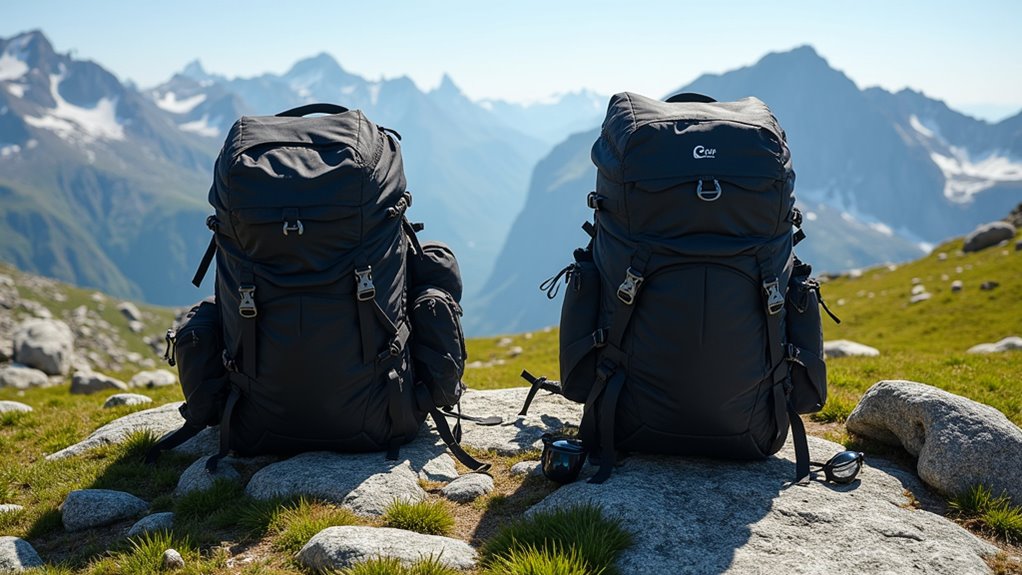
Just discovered 12 game-changing strategies that cut backpack weight in half—the #7 trick will completely revolutionize your hiking experience.
You’ll feel every ounce on those steep climbs when your pack’s loaded down with unnecessary gear. The difference between a 40-pound and 25-pound pack isn’t just comfort—it’s the difference between enjoying your hike and enduring it. Smart backpackers know that cutting pack weight doesn’t mean sacrificing safety or comfort. It’s about making strategic choices that’ll transform your trail experience, and there are twelve proven methods that can dramatically lighten your load without breaking your budget.
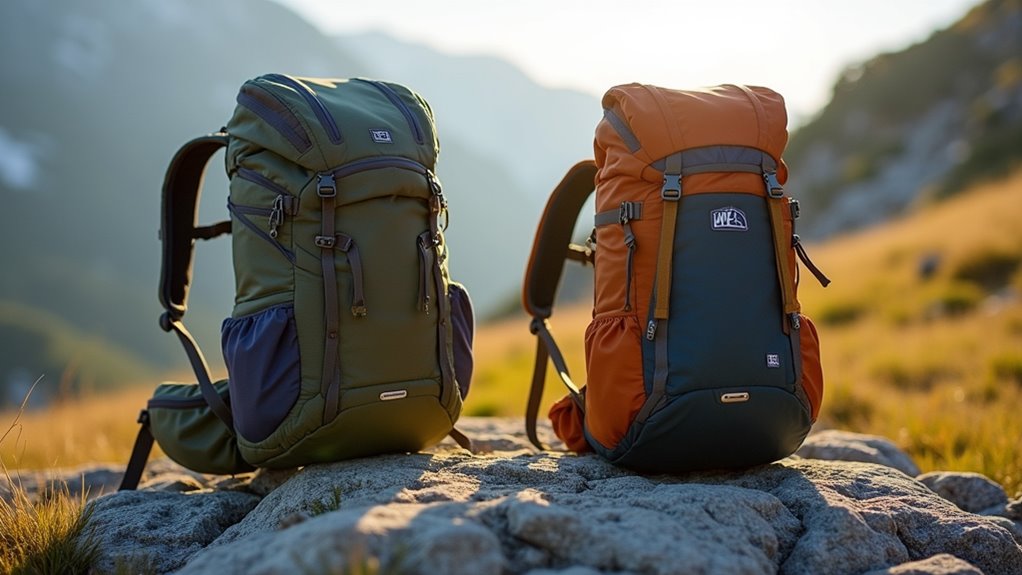
Your backpack’s base weight sets the foundation for everything else you’ll carry, so selecting an ultralight model can instantly shave 2-4 pounds from your total pack weight. Look for packs weighing under 2 pounds that use lightweight materials like Dyneema or ripstop nylon.
Your backpack’s weight determines everything else you carry, so choosing ultralight materials like Dyneema can instantly cut 2-4 pounds from your load.
Skip unnecessary features like multiple pockets, heavy zippers, and bulky frames unless you absolutely need them.
Frameless packs work well for loads under 25 pounds, while lightweight internal frames handle heavier loads without the bulk of traditional models.
Consider your torso length and capacity needs – don’t go bigger than necessary since you’ll be tempted to fill extra space.
Test the pack’s comfort with weight before committing, as even the lightest pack becomes unbearable if it doesn’t fit properly.
Research shows that choosing the perfect camping backpack requires balancing weight savings with durability to ensure your gear can withstand the demands of multi-day adventures.
After lightening your pack itself, shelter represents your next biggest opportunity to cut weight dramatically. Traditional tents can weigh 3-5 pounds, while ultralight alternatives drop that to 1-2 pounds without sacrificing protection.
Consider a single-wall tent instead of double-wall designs. They’re lighter because they eliminate the separate rainfly.
Trekking pole tents save even more weight by using your hiking poles as tent poles, eliminating dedicated tent poles entirely.
For solo hikers, a bivy sack paired with a tarp offers maximum weight savings. You’ll get weatherproof protection at under one pound total.
Don’t overlook your sleeping system either. Swap that heavy sleeping bag for a quilt, which eliminates the back portion you’d compress anyway.
Choose a sleeping pad with the highest R-value per ounce for your conditions.
When camping in areas with tall grass or wooded regions, remember that tick prevention becomes crucial as these environments are prime habitats for ticks that can transmit diseases.
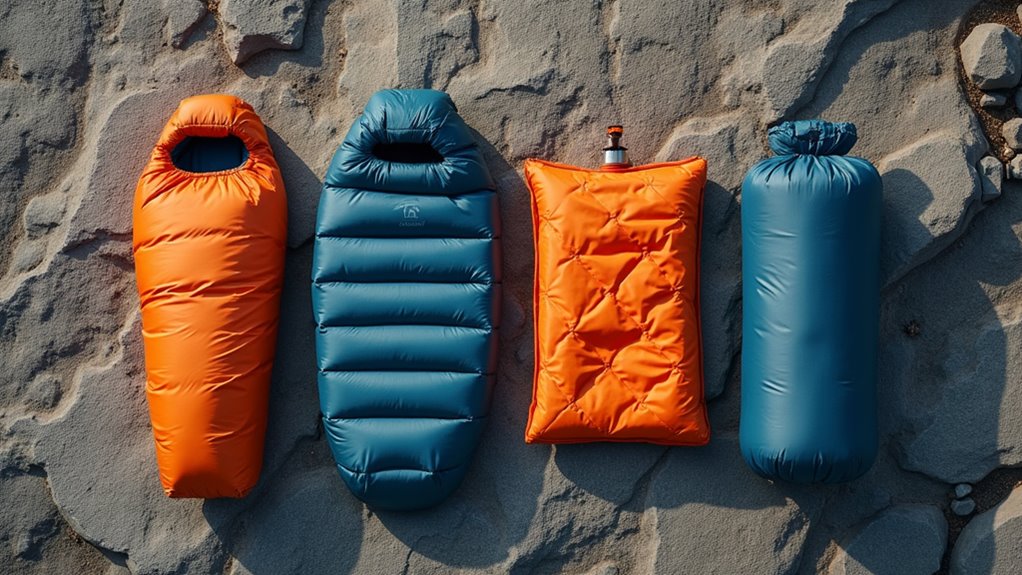
While shelter protects you from the elements, your sleep system directly impacts how well you’ll rest on the trail—and it’s another area where smart choices can slash significant weight.
Your sleeping bag typically weighs the most, so prioritize down insulation over synthetic materials. Down packs smaller and weighs less while providing superior warmth-to-weight ratios.
Consider a quilt instead of a traditional sleeping bag—they eliminate the compressed insulation beneath you that provides little warmth anyway.
Choose your sleeping pad wisely. Ultralight inflatable pads offer excellent insulation and comfort while weighing under a pound.
Skip the pillow and stuff clothes into your sleeping bag’s stuff sack instead.
Understanding the different sleeping bag types available will help you make the most informed decision for your specific backpacking needs and climate conditions.
Every ounce you shed from your sleep system means easier miles ahead.
Beyond optimizing individual gear categories, the smartest weight-cutting strategy involves choosing equipment that serves multiple purposes. Your trekking poles can double as tent poles, eliminating dedicated tent stakes. A bandana works as a washcloth, first aid compress, or pot holder. Pack a smartphone instead of separate GPS, camera, and entertainment devices.
Choose clothing that shifts from hiking to camp wear. Merino wool base layers regulate temperature while doubling as sleepwear. Your rain jacket serves as a windbreaker and pillow stuff sack.
Consider gear combinations like a spork instead of separate utensils, or a headlamp with red light rather than carrying a separate reading light. Every item you carry should ideally serve at least two functions, maximizing utility while minimizing weight. Just as divers must carefully manage their equipment to avoid buoyancy control issues that can lead to dangerous situations, backpackers benefit from strategic gear selection that prevents unnecessary weight from compromising their safety and enjoyment on the trail.
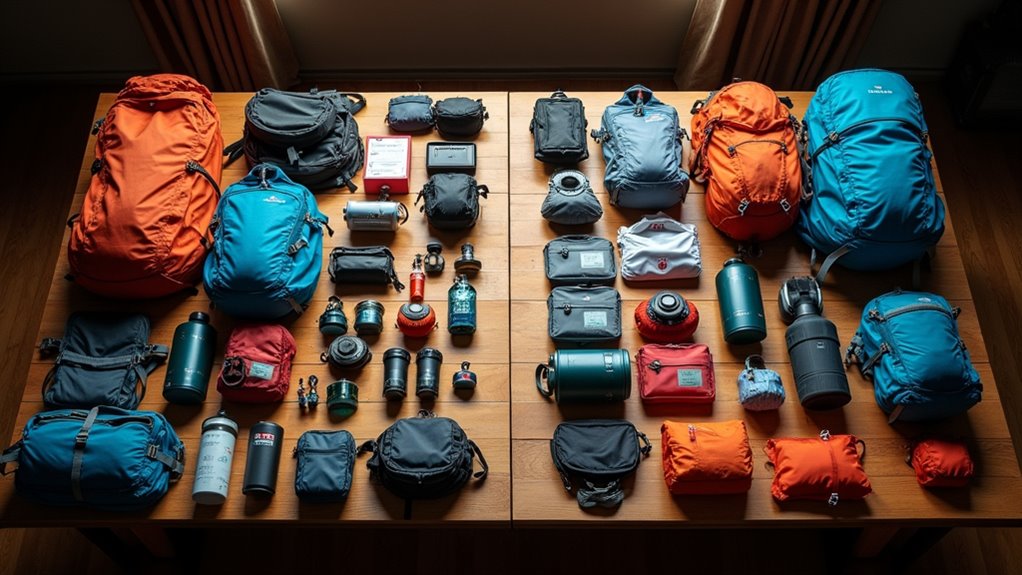
Even with multi-use gear selected, most backpackers still carry duplicate items without realizing it. You’ll shave significant weight by identifying these overlaps and making strategic choices about what stays and what goes.
Common redundancies that’ll lighten your load:
Review every item’s function before packing. If two pieces of gear serve the same primary purpose, choose the lighter, more versatile option.
This simple elimination process often removes 1-2 pounds without sacrificing functionality. Consider packing strategies for different weather conditions, as rainy weather backpacking may require you to prioritize waterproof gear over redundant items.
How much weight are you carrying just to boil water and heat meals? Your cooking system can easily add several pounds to your pack if you’re not careful. Ditch the heavy camp stove and opt for a lightweight canister stove that weighs under four ounces.
Skip the bulky cookset and bring just one titanium pot that doubles as your bowl and mug.
For water, forget the heavy bottles. Use collapsible water containers or hydration bladders that weigh almost nothing when empty. Consider lightweight water treatment options like purification tablets instead of heavy pump filters.
You can also pre-portion your meals into lightweight packaging rather than carrying original containers. These simple swaps will shave pounds from your pack without sacrificing functionality.
Don’t forget that a lightweight sleeping setup is equally important – consider choosing the best air mattress that balances comfort with minimal weight for your backpacking adventures.
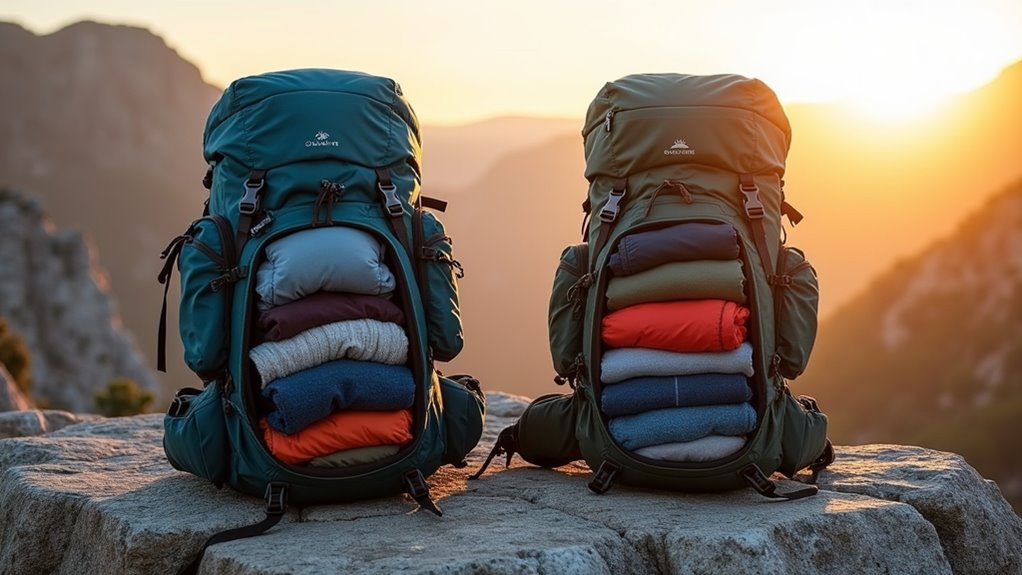
While it’s tempting to pack for every possible weather scenario, clothing often becomes the heaviest category in your backpack. You’ll dramatically reduce weight by sticking to versatile layers that handle multiple conditions instead of specialized items for every situation.
Smart packing means choosing versatile layers over specialized gear to dramatically cut backpack weight without sacrificing weather protection.
Focus on these essential clothing strategies:
Limit yourself to one extra pair of underwear and socks. You can wash items during longer trips, eliminating the need for multiple changes of clothing.
Since modern backpackers often carry multiple electronic devices, gadgets can quickly become a significant weight burden that rivals even your clothing load. You’ll want to prioritize your most essential electronics first. Choose a lightweight power bank over multiple batteries, and consider solar chargers for extended trips.
Replace heavy cameras with your smartphone if it takes quality photos you’re satisfied with.
Leave redundant devices at home—you don’t need both a GPS unit and smartphone with offline maps. Opt for multi-purpose items like a phone that doubles as your flashlight, compass, and entertainment system.
Consider sharing electronics with hiking partners when possible. One group GPS or emergency beacon can serve everyone, cutting individual weight while maintaining safety standards.
Plus, investing in a unique travel backpack with built-in organizational features can help you distribute electronic weight more efficiently and avoid unnecessary charging cables or protective cases.

Original packaging adds unnecessary weight that accumulates quickly across all your food and toiletry items. You’ll be amazed how much weight you can shed by transferring everything into lightweight containers.
Here’s how to repackage effectively:
These lightweight packing principles apply whether you’re preparing for a multi-day wilderness trek or getting ready for family adventures like guided river trips where pack weight still matters for portaging and hiking segments.
After trimming weight from your food and toiletries, your navigation and safety equipment deserves the same scrutiny. Your smartphone with downloaded maps can replace a heavy GPS unit and paper maps. Choose a lightweight headlamp over a bulky flashlight, and pack backup batteries instead of multiple light sources.
Replace a heavy first aid kit with a compact version containing only essentials like bandages, pain relievers, and blister treatment. Swap out thick rope for lightweight paracord that serves multiple purposes. Consider a whistle instead of bear bells for emergency signaling.
Choose a lightweight emergency shelter like a bivy sack rather than a heavy tarp. When selecting your gear, prioritize items that support low impact camping principles to minimize your environmental footprint on the trail. Every ounce counts when you’re carrying your gear for miles.
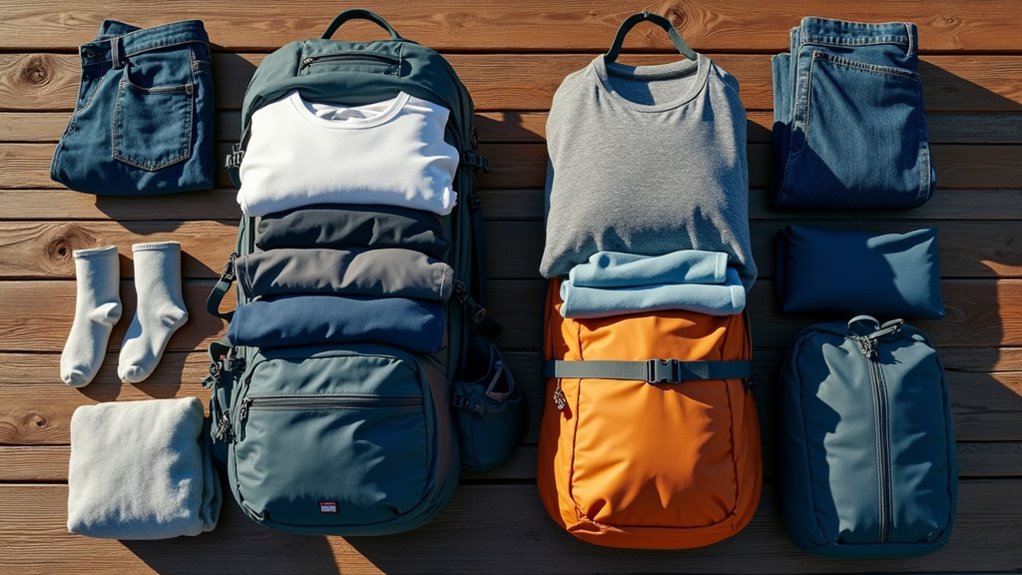
While cotton feels comfortable in everyday life, it becomes your enemy on the trail. Cotton absorbs moisture and holds it against your skin, creating a recipe for hypothermia and discomfort. When wet, cotton loses all insulating properties and takes forever to dry.
Replace cotton items with synthetic materials or merino wool alternatives:
You’ll stay warmer, drier, and more comfortable while reducing pack weight since synthetic materials are typically lighter than their cotton counterparts. This principle becomes especially critical on multi-day treks like Scotland’s West Highland Way, where unpredictable weather can quickly turn cotton clothing into a safety hazard.
Before you stuff items into your pack, grab a scale and weigh each piece of gear individually. You’ll be shocked at how quickly ounces add up to pounds. That “lightweight” sleeping bag might actually weigh three pounds, while your water bottle could be heavier than expected.
Create a simple spreadsheet listing each item and its weight. This visual breakdown helps you identify the heaviest culprits in your pack. You’ll quickly spot opportunities to swap heavy items for lighter alternatives or eliminate unnecessary gear altogether.
Don’t skip weighing small items like toiletries, first aid supplies, or camp tools. These seemingly insignificant pieces often contribute more weight than you’d think. When you see the numbers on paper, you’ll make smarter packing decisions and prioritize only essential items.
When evaluating your sleeping bag options, consider that waterproof sleeping bags offer protection advantages that might justify their weight for certain backpacking conditions.
You’ll feel the difference immediately when you apply these weight-cutting strategies. Take Sarah, who dropped her pack from 45 to 28 pounds by switching to a quilt, titanium cookware, and repackaging her toiletries. She covered twice the daily mileage with less fatigue and joint pain. Start by weighing everything you currently carry, then systematically replace the heaviest non-essential items. Your back will thank you on mile fifteen.